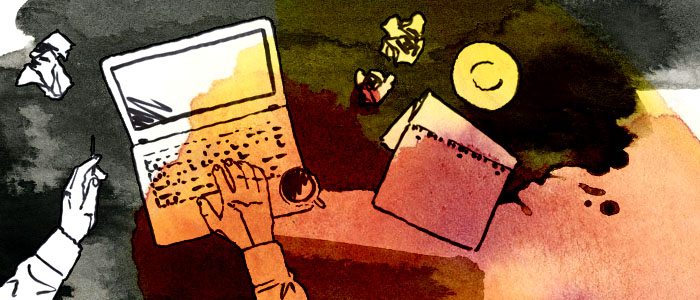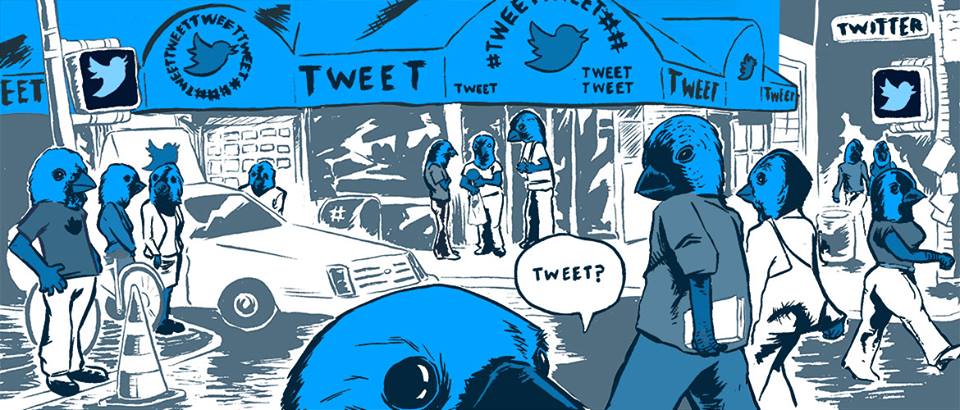Illustrated by Fahren Feingold
Aren’t you tired of bosses, teachers, writers, coaches, and self-help types breaking out the “house” metaphor to get a point across about some project or lesson, telling us all about the “tools,” the “bones,” the “building,” the “planks,” the “levels,” the “rooms”?
You’d think these so-called thought leaders and expert communicators could come up with something new after all of this time. But once more couldn’t hurt too much, right?
So, I want you to imagine the post you’re working on … as a house.
It’s your house. You closed on it recently, and are moving in today. You’ve come a long way to get here, and now you’re standing on the front stoop. It’s the perfect size, with a lot of potential.
Your research has been exhaustive in acquiring the sturdiest furniture, the most effective and reliable appliances. It’s all ready to be unboxed, assembled, and installed. And everything is scattered about, in the wrong rooms, haphazardly. It’s a mess. Chaotic, even. All you want to do is get inside and impose some order. Make sure everything is put in its place. You’ve got friends coming over tonight!
You reach into your hip pocket for the key. Nothing. You check the other one. Same deal. You check all of ’em – you’re wearing cargo pants, so the whole thing’s pretty suspenseful. A crowd even gathers to watch, with two dudes holding chickens against their chests taking bets on whether you’ll find it.
You don’t.
You walk around back, but the gate is locked, too. It’s getting dark. You plop down on the stoop with your head in your hands, feeling around the concrete. You halfheartedly scan the grass. Still no key. Did you ever even have it? Did you leave it somewhere? Did it slip through your fingers? How are you ever going to get inside of your house?
Story Angles Are Your Way In
If you’re reading this, you’re probably a business with a blog, and you have no idea where to start when it comes to developing new content.
In this metaphor, tortured within an inch of its life, we already know the house stands for the blog post you need to produce, right? But what about the key?
[Tweet “Your angle is the key – your way inside the story. Its cut & groove are unique to your work.”]Your angle is the key. Its cut and groove are unique to your work. It’s your way – and, more to the point, the reader’s way – inside of the story.
Think about your post as if you’re preparing to give a TED talk: What nugget will you leave your audience with?
Without your angle, there is no article; just a bunch of names, facts, and quotes filling up some space in a disjointed, incoherent hodgepodge. You’d be better off producing a listicle. And that’s fine if you do: Deploying a list as your delivery mechanism for content is 100 percent legitimate, as long as there’s a true unifying theme – which is just another term for an angle – and justification for the format being the most effective for your readers’ enjoyment and understanding.
By the way, the best lists are still built on great writing. You still have to provide strong context, sharp content, and compelling data.
When you’re putting together a piece, no matter what the length or subject, an angle should guide you through the entire process. This starts way before you sit down and start typing. You should set out with an angle – as original a one as possible – at least partially formed in your mind, and it should inform your research, interviews, and writing. At no point do you want to bend your findings to fit your angle, of course, but you do want to adhere to it in your approach, if possible – ideally through the period in your very last sentence. You want your angle to be strong and well-considered before setting out.
Choosing an angle can be challenging – I find it to be the most challenging aspect of writing for publication, in fact – because there are often many entry points and exit strategies for a post. You’re in charge. You’re guiding readers. It’s your perspective defining the experience.
As a writer, you have options. Like, infinite ones. It’s daunting. The game theory and possible permutations involved in writing an article – even a short one – will defeat you if you don’t organize your thoughts early in the project.
This, though, can be flipped around and turned into a positive: You have the power to set the course of the post. If it’s complicated, you can simplify it. If it’s murky, you can clarify it. If it’s boring, you can spice it up. If it’s short on facts, you can find more of them. You can seize upon something the other guys missed. You can make it your own.
Story Angles Help You Sift Through the Pile
Some years ago, I was assigned by The Austin Chronicle to profile Mark Zupan, the principal subject of a fascinating documentary on the paralympic sport “quad rugby” called Murderball. Zupan lived in Austin, where the film premiered at South by Southwest. It then went on to tour the festival circuit with tremendous success, eventually earning an Oscar nomination. Nearly everywhere you looked, from competing publications in town to Entertainment Weekly to The New York Times, Zupan’s compelling story of adversity and triumph – itself a familiar trope – was splashed across the page.
By the time the film would be released theatrically – and, in turn, when my story would run – I knew all aspects would be covered many times over. I also knew things would have gone from saturation to oversaturation.
I thought about possible angles for a few days, and then told my editor-in-chief I believed that the only way to offer a fresh take was to shadow Zupan for a week and embed myself in what was essentially his entourage at the time. In order to do this, I said, I’d need a round-trip ticket to Los Angeles and an expense account. The angle: the making of an unlikely superstar. Here’s this local guy in a wheelchair working at a software company who thought his life was all but over after a tragic accident becoming the toast of independent cinema overnight. The injury that had paralyzed him had transformed him into a celebrity. How had it all happened? How was he handling it? And what was it like meeting Regis Philbin?
 To my happy surprise, the EIC approved the plan, and my story was on its way. I worked my tail off covering it and knew my angle was the right one when, while listening in to a conversation Zupan was having with the film’s publicist at a L.A. Film Festival screening, I heard her say to him, “I have a big pile of you on my desk.”
To my happy surprise, the EIC approved the plan, and my story was on its way. I worked my tail off covering it and knew my angle was the right one when, while listening in to a conversation Zupan was having with the film’s publicist at a L.A. Film Festival screening, I heard her say to him, “I have a big pile of you on my desk.”
Now, it wasn’t going to win any Pulitzers, but that story stood out from the crowd. I let the angle lead me from conception through execution, and despite the dozens of hours of audio and reams of notes I had to sift through, the nights when I struggled with the long-form writing process itself, I kept my confidence and composure because I knew I had found my way in. I also knew our readers would enjoy it, and that thrilled me. Turned out, Zupan enjoyed it, too.
I bring this up mainly because, on a business blog – whether B2B or B2C – getting your subjects to like what you write about them is the goal. It’s essential. The takeaways should always be positive, especially when they center on your product.
When Zupan read the piece, he asked me to join him and his girlfriend for a drink. As I was telling him I liked his t-shirt, the dude literally took it off of his back, asked for a marker from the bar while sliding his hoodie back on, and signed the shirt “Thank you for caring so much about my story” before giving it to me. And we hadn’t even finished the first round of beers!
I understand if you need a moment to compose yourself after that emotional anecdote. When you’re ready, we can look at another example.
Story Angles Make a First Impression
OK: You’re crafting a press release or blog post for the debut of your company’s new camera.
Your camera actually has multiple uses depending on the mode the consumer sets it to – exemplary still photography, decent video, nifty projection capability, above-average social media features, even dedicated audio recording – but some uses have tested more strongly than others. There are even features that weren’t intended! The built-in pop-up flash bends and flexes because of the kind of plastic the designers chose, for instance, enabling the photographer to bounce light creatively, but your engineers aren’t convinced this is the best idea. Still, it’s pretty cool, and people are going to talk about it.
This is an attractive camera with a ton of style. The body’s got great retro aesthetics. The golden demographic is gonna love it. If they can afford it, which most probably can’t. Oh, come on, you say, it’s cheaper than a Leica (neglecting to mention that some new cars are, too). But the cost could be problematic.
So, pick your path. What do you focus on in your press release? Your company blog? Your social media? Your email newsletter?
The camera’s calling card – great pictures? Its versatility? Its looks? Its less-terrifying-than-a-Leica pricetag? You don’t want to dilute your product’s power or overwhelm your readers. Remember, you never get a second chance to make a first impression. In messaging, it’s very difficult to reset or backtrack, so you must choose wisely.
 Check out how FujiFilm has chosen to handle the roll-out of its X-series. Setting a new standard with this prosumer product, they’ve also set a new standard in content marketing. They opened up the telling of the X-Series’s story to both the technologists and hobbyists among the digital camera crowd, including on its blog “Users’ Voice” and “From the Creators” features.
Check out how FujiFilm has chosen to handle the roll-out of its X-series. Setting a new standard with this prosumer product, they’ve also set a new standard in content marketing. They opened up the telling of the X-Series’s story to both the technologists and hobbyists among the digital camera crowd, including on its blog “Users’ Voice” and “From the Creators” features.
Chances are, this decision – setting the angle of your promotional material – will have great impact on your product’s fate. How many people, for better or worse, put down a book if they don’t like the first chapter? Reviewers and consumers, particularly in niche markets, can have memories like elephants.
If you’re a new company, the stakes are that much higher.
The Hook: Story Angles Keep Blogs Fresh
Speaking of cameras, let’s talk about photography and movies to wrap this installment up. And, while we’re at it, pop songs. The following will help clarify and give you a better feel for angles, since the concept can be somewhat abstract and subjective.
- When someone refers to the angle of a photograph, they’re mostly likely talking about the position of the camera, chosen by the photographer, as it corresponds to the position of the subject. In other words, the point of view. So it is with the angle of a story.
- In film, a through line can refer to the idea of an actor thinking of her role in the context of the entire plot rather than scene by scene. It can also mean the “spine” or “thread” of the plot itself. Again, a good way to look at an article’s angle.
- In pop music, the hook is essential to attracting and keeping a listener’s attention. It ripples throughout a song, and is an unmistakable signature. This is what your research, reporting, and writing should aspire to. This is what editors look for in features – an angle. OK, so the weekly 600-word blog post on your industry’s latest trends won’t be a masterpiece like “(I Can’t Get No) Satisfaction” that people will listen to thousands of times. It can still stand out from the crowd and bear the stamp of your style and expertise.
Above all, you want to keep your writing from lapsing into static and boilerplate. Finding story angles – which, in your head or on paper can range from a short phrase to a page-long pitch – will help you accomplish this. They’re crucial to enticing your audience to come back time and time again.
Your goal is to convert readers into customers, and turn customers into brand loyalists. In order to do that, you’ll need to figure out just who your readers are. After all, audience is everything. We’ll cover that in the coming weeks.
Does your business blog play all of the angles better than a pool shark? If so, please share some tips in the comments. If not, give us a call – we can help get you there!











